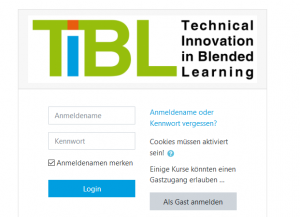This is a short summary of the items relevant for the course implementation. Additionally, an interactive checklist is available to find out, if a course implementation fits to the TIBL concept.
Interactive checklist: 
Considerations for the Implementation
The TIBL Method is based on Blended Learning (as the delivery model of the course). This requires training based on onsite learning (group based) and a Distance Learning part (here called “Distance Training”, realized with the Moodle platform).
Preparation work – Preconditions
The implementation of a course implicates a certain preparation. This must cover
- Course planning
- Course design
If you are not sure about these items, please read the section in the MOOC or the short explanations in the toolbox description.
Onsite Training
The preparation work for a TIBL method course must include the setup of the onsite teaching (room(s), facilities, time table), the availability of the material (copies, electronically delivered material), organizational issues (planning of learning groups, use of labs, schedules), assignments and assessments.
Distance Training
For the Distance Training all the materials must be available (provided by the learning platform) in a ready-to-use form. This includes the correction of the material, needs the use of approved and pre-tested lessons (or learning units) and requires the delivery in the appropriate way (branding of the material, defined delivery processes, availability of the necessary bandwidth for the delivery, and related items).
The Trainer’s Role and Education
Blended Learning changes the role of the trainer (in the TIBL method, the trainer shifts from the simple “responsible for knowledge transfer and assessment of training results) to a facilitator and coordinator of the training. In the same way the trainees should develop to self-determined learners.
Make sure that all involved trainers are well-educated to run the course (in the sense of the issues mentioned above). In the TIBL method trainers are the facilitators of the training, they are responsible for a lot of essential tasks:
- Guide trainees through the course
- Motivate trainees
- Supervise the onsite training (for example the moderation of group work, discussion rounds, practical hands-on training)
- Give (positive motivating) feedback in various cases (for example in forums, answering and reviewing assignments, moderation of web-based group work)
- Give support to trainees
- Care for the weaker trainees through the personalised delivery of adapted material and a closer tracking of their performance to detect when and where they need extra help.
- Evaluation of trainees’ activities (for example online activities in the training platform)
- Initiate, perform and evaluate various forms of assessments (for example online assessment, or group base onsite assessment, formative as well as summative assessment)
Miscellaneous issues
Courses should provide some way of individualized training. This can be implemented using different ways or approaches. Training paths can be complex and provide several parallel structures – this enables a big number of possibilities and combinations. Each combination of individualized training paths must be tested on consistency and appropriate working. An individualization also is possible using interactive videos (this works by selecting specific items and the video continues at the relevant scene defined with the timeline).
This short video gives a short introduction to individualized training.
Video: Short overview of simple individualisation (Peter Mazohl), Source: TIBL-Chanel (YouTube)
Technology
Control and check the technical infrastructure that is used for the training. This affects the onsite training (where normally some infrastructure is needed to perform the training) as well as the technology behind the Distance Training.
For onsite training in most cases a robust network (today based on WLAN using WiFi) is the standard.
For the Distance Training the Moodle server must provide the needed capacity, shortest response times, and a well-working connection to the internet providing the necessary bandwidth for the expected number of trainees and the type and weight of the contents or data to be retrieved.
Use of Material
The material provided for the course should be created following the guidelines as mentioned in the chapter about course creation. This should make it easy for trainees to handle the content, the individual assignments or the group work.
For training in a company (employees of this SME) the material used must comply with the corporate identity.
Multiple Devices
Trainers should give attention to the use of multiple devices. All material, especially multimedia material, should be tested on all possible devices (differences in technical layout or in the used operating system). Content – delivered by the preferred platform (Moodle for the TIBL method) – normally can be displayed without problems on all devices. Nevertheless, a pilot testing on various devices is mandatory. In the case of problems, these either must be fixed before the course starts or must be mentioned before the course starts.
There are free, easy-to-use tools that can be used to check how a particular content will be displayed in different devices (tablets, smartphones, PCs, etc.). A good example of these is QuickTools screenfly, a webpage that – among many other features – can use different device emulators to display a given web content. We strongly recommend using one of these tools in order to design training contents for multiple devices.
In certain cases, an “exclude list” (naming devices that cannot be used in the course due to a specific reason) should be given to the participants (at the enrollment to the course). It is good praxis also to mention the reason why this device cannot be used (for example: screen too small, no suitable pointing device available, etc.).
Recommendation: Some multimedia-based material is available as an executable file only. These types of programs depend on the operating system of the device being used and therefore such programs cannot be used with all devices. These products should be avoided and replaced by web-based material.
Multimedia-based Content
This content also should be tested on all possible devices including the usability of the multimedia tools.
Recommendation: Check the usability of the multimedia tool in relation of the screen size and/or the necessary use of a pointing device (Further information can be found in the MOOC, Unit “Use of multiple devices”.
External resources
All external sources must be checked for availability before the course starts.
Recommendation: The TIBL concept bases on the use of a MOODLE server as the training platform. All materials should be available there. If you use external sources (for example some specific web 2.0 interactive tool) you should care to make this material to be accessed via the training platform (for example by describing the assignment in the training platform and to put a link there) or by embedding the external material in the course (Two examples: the embedding of a YouTube video or the use of material from a cloud-based repository).
Feedback
The necessary feedback must be prepared and available at the beginning of the course. This should cover
- Feedback of trainees
Feedback of trainers
Both types of feedback belong to the “feedback culture” and should be used in the evaluation of the course.
Hint: feedback to trainees is a crucial item for successful learning (as described in the training framework).
Recommendation: If possible, define a feedback based on benchmarking. This means that the people giving feedback compare the course with given descriptions. The result can be used for amendment of the course (for the next edition). Further information is available in the chapter about evaluation (in the toolbox).


